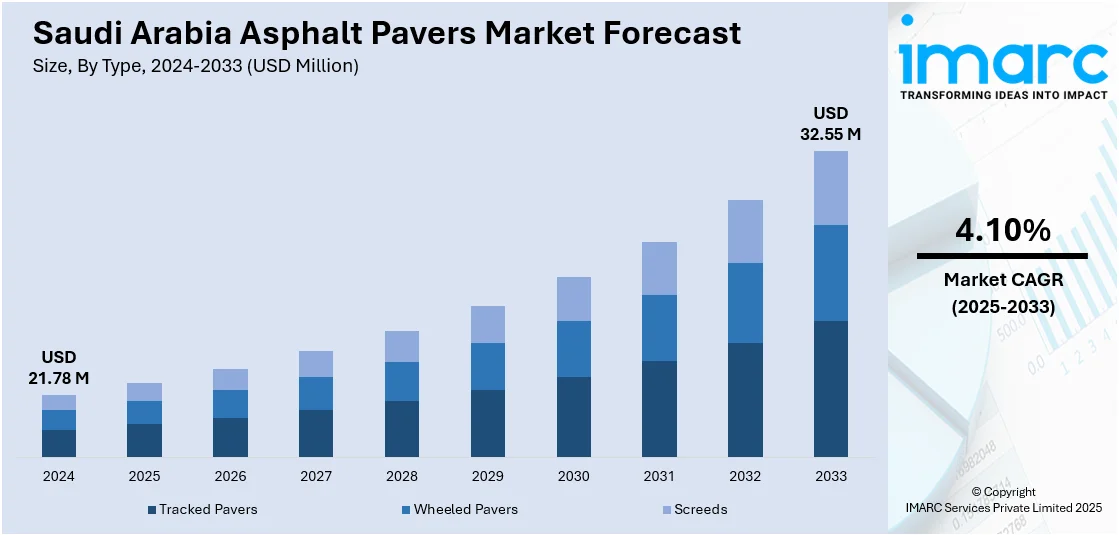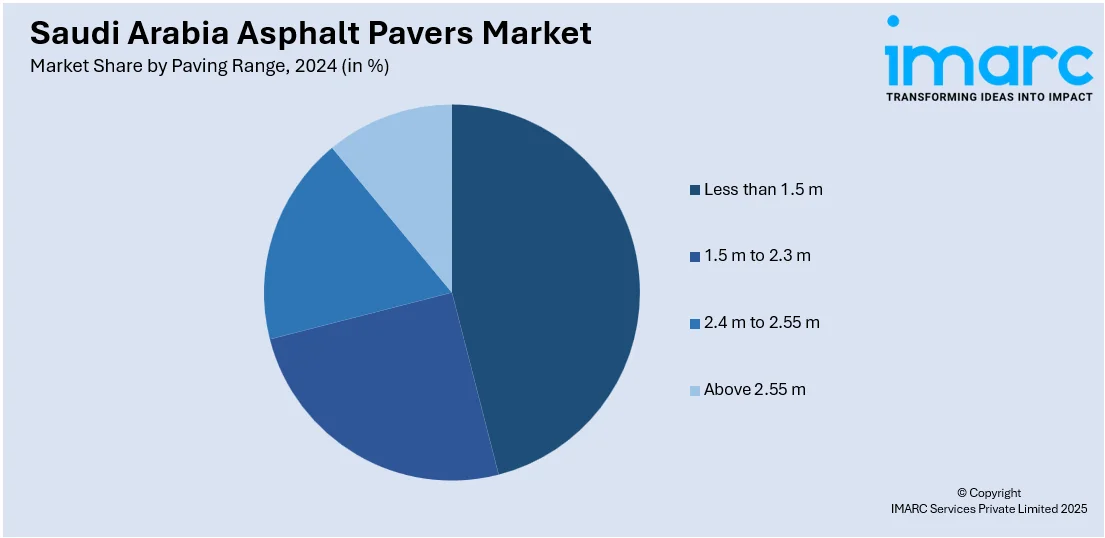
Saudi Arabia Asphalt Pavers Market Size, Share, Trends and Forecast by Type, Paving Range, and Region, 2025-2033
Saudi Arabia Asphalt Pavers Market Overview:
The Saudi Arabia asphalt pavers market size reached USD 21.78 Million in 2024. Looking forward, IMARC Group expects the market to reach USD 32.55 Million by 2033, exhibiting a growth rate (CAGR) of 4.10% during 2025-2033. The market is expanding as road construction accelerates under Vision 2030, supported by smart city projects and upgrades to logistics routes. This rising demand for advanced paving machines is directly influencing Saudi Arabia asphalt pavers market share across both public and private sectors.
|
Report Attribute
|
Key Statistics
|
|---|---|
|
Base Year
|
2024
|
|
Forecast Years
|
2025-2033
|
|
Historical Years
|
2019-2024
|
| Market Size in 2024 | USD 21.78 Million |
| Market Forecast in 2033 | USD 32.55 Million |
| Market Growth Rate 2025-2033 | 4.10% |
Saudi Arabia Asphalt Pavers Market Trends:
Rise in Road Infrastructure Projects
Saudi Arabia is expanding its road and transport infrastructure as part of Vision 2030, creating continuous demand for asphalt pavers across the country. The need to strengthen intercity road links, widen existing highways, and construct rural roads is pushing contractors to invest in modern paving machinery. As traffic volumes grow, authorities are emphasizing quality construction and timely project completion, leading to wider use of mechanized paving solutions. Contractors are focusing on reducing project delays and maintaining uniform pavement layers, which is increasing the use of sensor-based asphalt pavers. In the latter part of 2024, the Ministry of Transport and Logistics Services issued several tenders for road upgrades across Riyadh, Makkah, and the Eastern Province. The awarded projects led to bulk procurement of wheeled and tracked pavers from both regional and international suppliers. Many machines were chosen for their fuel-efficient engines, automatic material feeders, and screed leveling systems. In addition, the ongoing upgrade of internal roads in industrial zones has driven steady demand from private developers. With a pipeline of roadworks planned for 2025–2026, especially to support tourism and logistics, the Saudi asphalt pavers market is expected to keep expanding, backed by both public infrastructure spending and private sector participation.

Growth of Smart and Mega Cities
The construction of smart cities and mega urban projects is becoming a key trend shaping the Saudi Arabia asphalt pavers market growth. Flagship developments like NEOM, The Line, and Qiddiya are driving the need for highly efficient, automated paving machinery. These projects follow strict quality and environmental guidelines, encouraging the use of advanced paving systems that can handle large volumes with minimal material wastage. Demand is also increasing for pavers with precision controls, reduced emissions, and faster operational capabilities to meet tight construction timelines. By late 2024, significant paving activities began in NEOM’s Oxagon industrial hub, as well as along arterial roads connecting residential and commercial zones. Construction firms engaged in these projects imported high-output tracked pavers and large wheeled models equipped with digital interfaces, thermal sensors, and GPS-linked control panels. These machines have enabled crews to lay smooth, even asphalt surfaces with better accuracy. Suppliers have reported strong inquiries from contractors involved in tourism, housing, and logistics corridor projects linked to Saudi Arabia’s urban transformation efforts. As more mega developments enter the execution phase in 2025 and beyond, the demand for next-generation asphalt pavers is likely to grow, especially among firms prioritizing speed, quality, and sustainable construction practices.
Saudi Arabia Asphalt Pavers Market Segmentation:
IMARC Group provides an analysis of the key trends in each segment of the market, along with forecasts at the country and regional level for 2025-2033. Our report has categorized the market based on type and paving range.
Type Insights:
- Tracked Pavers
- Wheeled Pavers
- Screeds
The report has provided a detailed breakup and analysis of the market based on the type. This includes tracked pavers, wheeled pavers, and screeds.
Paving Range Insights:

- Less than 1.5 m
- 1.5 m to 2.3 m
- 2.4 m to 2.55 m
- Above 2.55 m
A detailed breakup and analysis of the market based on the paving range have also been provided in the report. This includes less than 1.5 m, 1.5 m to 2.3 m, 2.4 m to 2.55 m, and above 2.55 m.
Regional Insights:
- Northern and Central Region
- Western Region
- Eastern Region
- Southern Region
The report has also provided a comprehensive analysis of all the major regional markets, which include Northern and Central Region, Western Region, Eastern Region, and Southern Region.
Competitive Landscape:
The market research report has also provided a comprehensive analysis of the competitive landscape. Competitive analysis such as market structure, key player positioning, top winning strategies, competitive dashboard, and company evaluation quadrant has been covered in the report. Also, detailed profiles of all major companies have been provided.
Saudi Arabia Asphalt Pavers Market News:
- January 2025: Alomaier Trading and Contracting Company expanded operations in Saudi Arabia by installing a high-performance concrete block and paver plant using Hess Group technology. This development enhanced local production capacity, supporting efficiency and quality in the Saudi Arabia asphalt pavers market for infrastructure projects.
- February 2024: Lintec & Linnhoff signed an exclusive distributor agreement with MEDCO in Saudi Arabia for asphalt mixing and concrete batching plants. This partnership strengthened local equipment availability and support, boosting operational efficiency and advancing the Saudi Arabia asphalt pavers market through enhanced distribution and service access.
Saudi Arabia Asphalt Pavers Market Report Coverage:
| Report Features | Details |
|---|---|
| Base Year of the Analysis | 2024 |
| Historical Period | 2019-2024 |
| Forecast Period | 2025-2033 |
| Units | Million USD |
| Scope of the Report |
Exploration of Historical Trends and Market Outlook, Industry Catalysts and Challenges, Segment-Wise Historical and Future Market Assessment:
|
| Types Covered | Tracked Pavers, Wheeled Pavers, Screeds |
| Paving Ranges Covered | Less than 1.5 m, 1.5 m to 2.3 m, 2.4 m to 2.55 m, Above 2.55 m |
| Regions Covered | Northern and Central Region, Western Region, Eastern Region, Southern Region |
| Customization Scope | 10% Free Customization |
| Post-Sale Analyst Support | 10-12 Weeks |
| Delivery Format | PDF and Excel through Email (We can also provide the editable version of the report in PPT/Word format on special request) |
Key Questions Answered in This Report:
- How has the Saudi Arabia asphalt pavers market performed so far and how will it perform in the coming years?
- What is the breakup of the Saudi Arabia asphalt pavers market on the basis of type?
- What is the breakup of the Saudi Arabia asphalt pavers market on the basis of paving range?
- What is the breakup of the Saudi Arabia asphalt pavers market on the basis of region?
- What are the various stages in the value chain of the Saudi Arabia asphalt pavers market?
- What are the key driving factors and challenges in the Saudi Arabia asphalt pavers?
- What is the structure of the Saudi Arabia asphalt pavers market and who are the key players?
- What is the degree of competition in the Saudi Arabia asphalt pavers market?
Key Benefits for Stakeholders:
- IMARC’s industry report offers a comprehensive quantitative analysis of various market segments, historical and current market trends, market forecasts, and dynamics of the Saudi Arabia asphalt pavers market from 2019-2033.
- The research report provides the latest information on the market drivers, challenges, and opportunities in the Saudi Arabia asphalt pavers market.
- Porter's five forces analysis assist stakeholders in assessing the impact of new entrants, competitive rivalry, supplier power, buyer power, and the threat of substitution. It helps stakeholders to analyze the level of competition within the Saudi Arabia asphalt pavers industry and its attractiveness.
- Competitive landscape allows stakeholders to understand their competitive environment and provides an insight into the current positions of key players in the market.
Need more help?
- Speak to our experienced analysts for insights on the current market scenarios.
- Include additional segments and countries to customize the report as per your requirement.
- Gain an unparalleled competitive advantage in your domain by understanding how to utilize the report and positively impacting your operations and revenue.
- For further assistance, please connect with our analysts.
 Request Customization
Request Customization
 Speak to an Analyst
Speak to an Analyst
 Request Brochure
Request Brochure
 Inquire Before Buying
Inquire Before Buying




.webp)




.webp)












